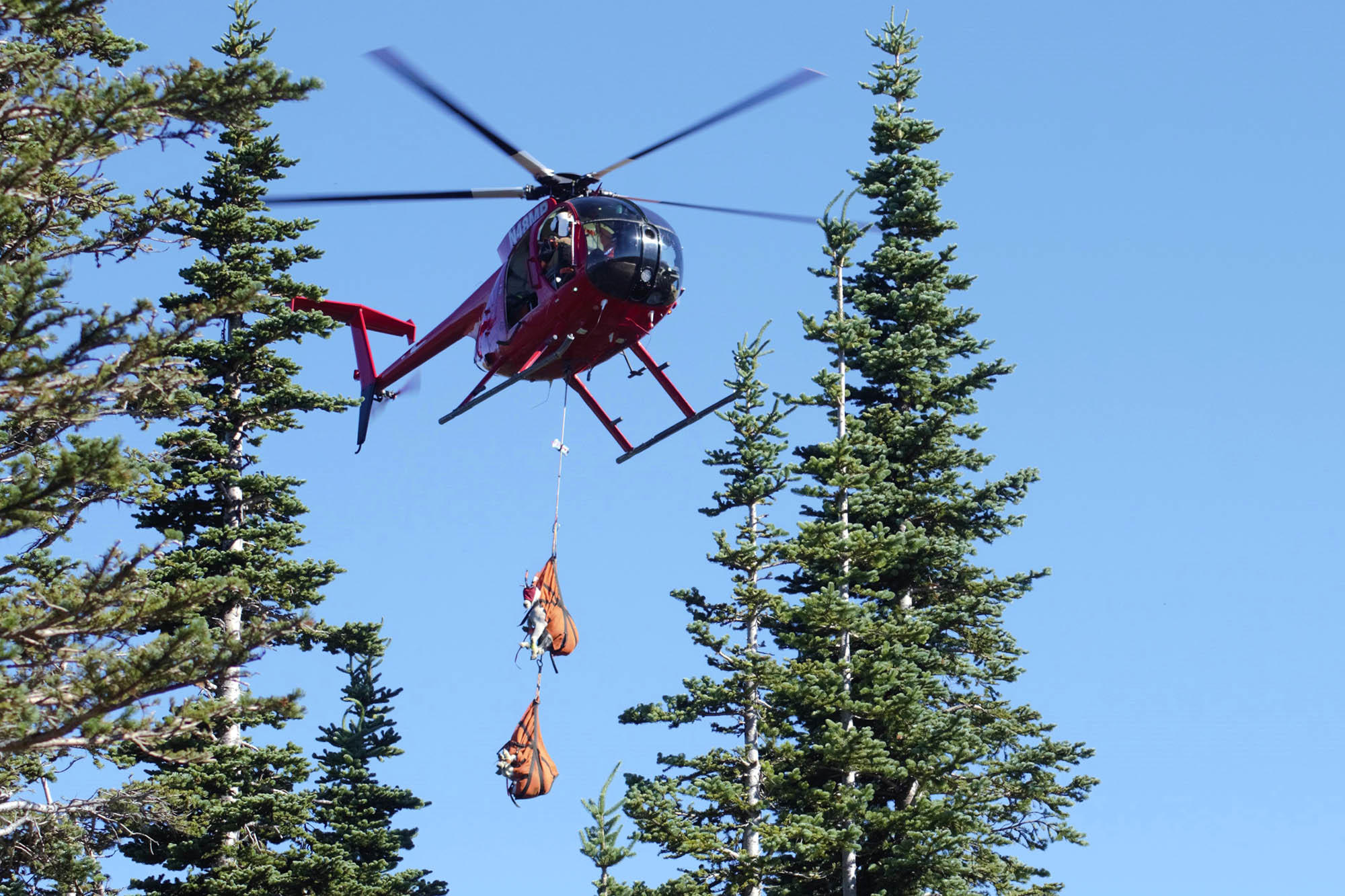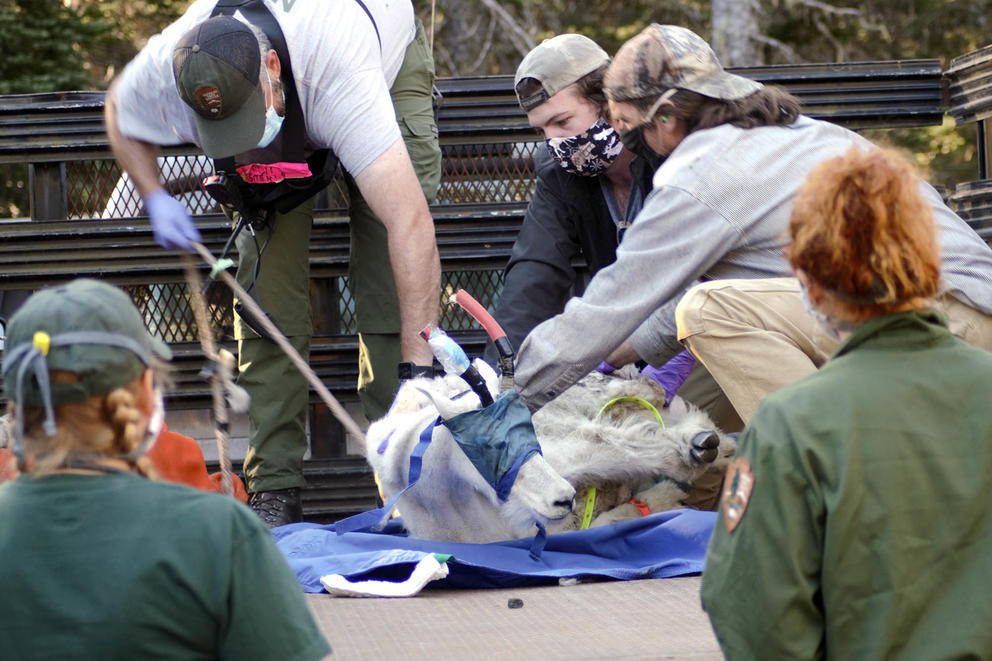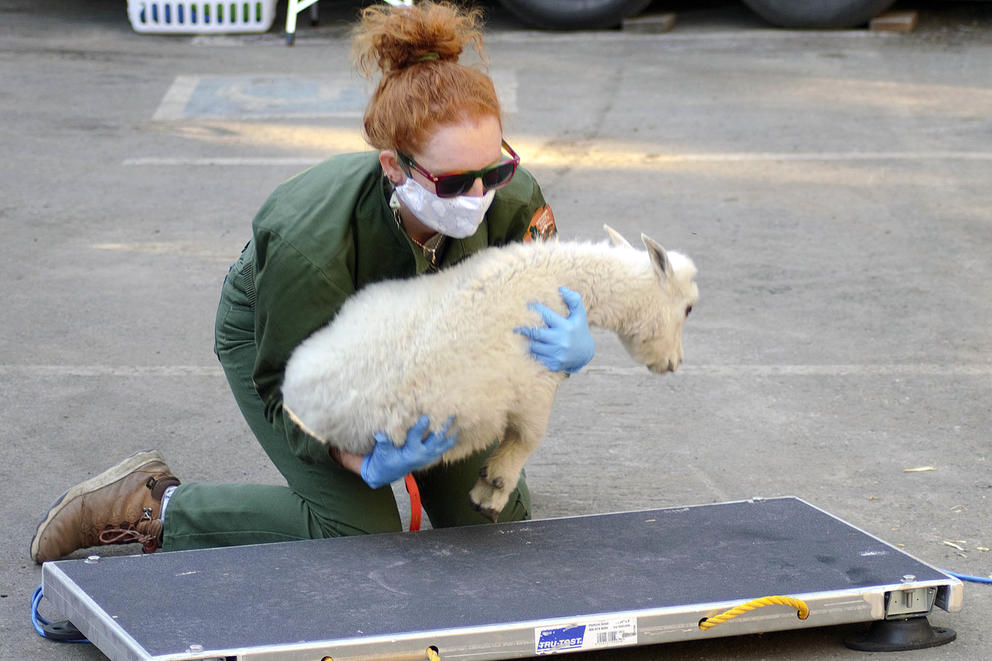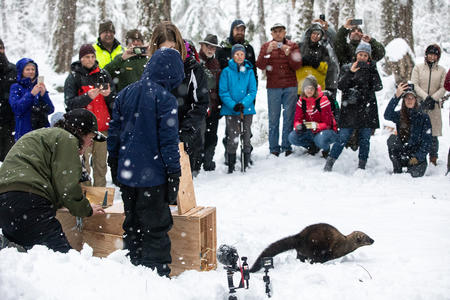“It was a little dicey getting all the protocols approved with all the [pandemic] modifications,” says Dr. Patti Happe, wildlife branch chief at Olympic National Park. When the project kicked off its fourth and final two-week relocation process on July 27, Happe says she breathed a sigh of relief.
Today, the team is reaching its goal of relocating about 50% of the Olympics’ mountain goats — a win-win for the Olympics and the North Cascades, two ecosystems suffering from a respective excess and lack of mountain goats.
The nimble alpine ungulates aren’t native to the Olympics, but they’ve flourished there since hunters introduced them in the 1920s, before the formation of the park, to the detriment of native species. Through decades of damaging endemic plants, they’ve also become increasingly aggressive toward humans, going so far as to kill a man in 2010. Goats need salt, and the Olympics lack natural salt deposits, leaving goats to stalk humans for their urine.
The North Cascades — which used to have more mountain goats — have those necessary salt deposits and more space to house goats away from humans.
By capturing goats with tranquilizer darts and net guns, and airlifting them out of the Olympics in not-quite-business-class bags suspended from helicopters, agency partners are turning a nuisance into a positive. “Reintroducing a species that's been artificially lost and getting rid of a species that's been artificially put in is generally a good thing to do when you can,” says Dr. Rich Harris, who led goat relocation in the years leading up to and during the first relocation effort before retiring.
But when collaborating agencies including the National Park Service and the Washington Department of Fish and Wildlife started coordinating this summer’s relocation, “nobody knew if we were going to be able to get to do this,” says Brock Hoenes, ungulate section manager with Fish and Wildlife. The whiplash of changing pandemic protective orders brought a whole new level of logistical complexity. Hoenes cautioned his team members that they would have to invest more energy in planning than usual and still court failure. “There’s no way to socially distance in a helicopter,” he notes. The agencies picked a “drop-dead date” of July 6.
When July 6 rolled around, the work sites were in Phase 2 of Gov. Jay Inslee’s “Safe Start” program to reopen the economy. The team created a strategy to work safely and salvage years of planning. Goats reproduce slowly, but every delay in relocation means more goats to remove later and more goats left to imperil human visitors and native flora.
“I'm glad that they're able to pull it off because I think if they had to wait for the pandemic restrictions to ease, it would be even harder to do,” Harris says.
To move a goat
For wildlife professionals, the relocation project is the experience of a lifetime.
“I'm pretty relieved that it's the last year,” says wildlife technician Annie Doss, also known as “Goat Handler Number One.” “Just imagine getting swooped up by a helicopter and sedated and put into a crate and then waking up in a different place — it’s pretty hard on the animals. But I really like being part of the process because I know that I’m doing my best to make it as OK as possible for the goats.”
In 2018, state and federal agencies, tribes and their partners began the plan to relocate approximately half of the mountain goat park’s estimated 725 goats. Technicians had removed 326 goats after three sessions; 275 were relocated to the Cascades, 16 animals were moved to zoos, and 35 died in the relocation process. As of Thursday, the team had released an additional 46 goats into the Cascades. Despite controversy, the remaining Olympic goats will be lethally removed this fall.
The process is surreal even in nonpandemic years. A contracted helicopter capture crew called “muggers” flies over remote goat habitat, tranquilizing goats from the air, Doss says.
Catching a goat is “pretty darn difficult,” Happe says, but the capture crews are good at judging whether an animal is safe to catch. They’ve only experienced one minor injury, when someone got horned by a goat last year while trying to get it into a bag.
Biologists like Happe receive the goats at helicopter landing sites, where veterinarians and wildlife technicians like Doss can take the bagged goats’ vitals and give extra sedative injections in close quarters. “The whole process is pretty crazy,” Doss says. “They just fly in with these bags of goats and drop them in a truck! It’s happening all very fast and close to you. And then you jump in the back of this truck and grab a goat — most of the time they have sedation drugs but sometimes not, and then they’re just jumping around a bit. But they’re hobbled and have horn guards and a mask on so it’s pretty safe.”
The crews put a radio collar on the goats for monitoring and wrangle them into transport crates in a refrigerated truck. For 400- to 500-pound male billies, wrangling a single goat requires a team of five or six people.
“You have to whisper when you're around the goats. People are working really hard, so quietly, it's almost eerie,” says Fish and Wildlife spokesperson Sam Montgomery.
Most of the time, though, the processing staff just hangs out. Helicopters bring in one to four goats at once, and vets and handlers stay on alert the rest of the time. Before COVID-19, they used to bring baked goods to share.
The entire transport crew is made up of more than 100 volunteers. Once they truck the goats to the North Cascades, another helicopter crew steps in to carry and deposit the goats at remote release sites high in the mountains. This year’s 12 release sites were in the the Mount Baker-Snoqualmie and Okanogan-Wenatchee national forests.
Staff members select sites based on things like existing goat population; important habitat features like steep alpine terrain with plenty of escape routes and easy access for helicopters and trucks.
Relocating hundreds of goats means closing those sections of the park. The National Park Service can't reasonably shut down areas of the park for months at a time, and the goats are safely accessible only in the summer. “We're walking that tension between capture efficiency, goat safety and also impacts on visitors in the wilderness,” Happe says.
Staggering the relocation sessions disrupts visitor access to the park for the shortest possible periods, and also offers more chances for good helicopter weather. Flight-foiling fog can roll into release sites even on days forecasted to have sun.
Even when conditions are ideal, risks remain for the mountain goats. The National Park Service evaluates capture statistics to improve the goats’ chances of survival, and they adjust practices as they learn (like switching to larger transport crates after two billies died in too-small crates during the first relocation session). The team waited to catch more until a partner organization in California drove up crates meant for larger bighorn rams; volunteers with Fish and Wildlife’s Master Hunter group then built 10 more large crates. “We haven’t lost any billies on the trip over since,” Happe says.
Same job, but in a pandemic
In a pandemic year, there are fewer people available for the same amount of work, and National Park Service support teams from Colorado, Alaska and California aren’t able to participate.
“It was kind of surprising to me that the mission was still going,” says Doss, “but it feels much more safe than I was assuming.”
Social distancing changed the feel of the process. Doss says handlers can play bocce ball in the parking lot, but she misses the communal baked goods. Doss says she was instructed to self-quarantine for two weeks before the start. Happe says workers are trying not to mingle, and participants must commit to a week of work in order to reduce the viral risk of high turnover. Volunteer truck drivers — often retired persons in high risk categories coming from all over the state — couldn’t participate this year, nor could tribal co-managers be present for releases. Staff who shared space in confined vehicles were required to wear N95 masks. Despite the hurdles, things are going smoothly, Hoenes says.
“It’s a lot less fun,” says Happe, who’s restricted to the helicopter base this year. “I’d like to go down to the processing unit and get to touch a goat, but I can’t. It feels successful but it’s a little bittersweet because I was kind of looking forward to this capture round being one where we could just relax and celebrate a job well done.”
What’s next
While the relocation is finishing, monitoring the goats’ progress will continue as long as their collars last — about four to five years, according to Hoenes. Putting hundreds of goats in GPS collars, Hoenes says, creates “a data set that’s almost unprecedented.”
The Department of Fish and Wildlife has been using that data to monitor the success of goats in their new homes. It’s comparing goat mortalities across release sites, how long it takes moving goats to settle down and more. It has altered their release site plans at least once based on that data.
The department has also seen survival rates of 50% on average one year after release, relative to 80% survival in natural populations. Billies survive 60% of the time, while nannies survive 45% of the time.
“There's been more mortality among those goats than I'd hoped for,” Harris says. “I'm still optimistic … but it will take some time [to see population growth] and it will go more slowly. One of the nice things about retirement is no longer looking at my computer screen and seeing those little red notices show up [that let you know] another goat has died. It just kind of hurt. … I think that's part of what you live with when you move animals.”
Goats reproduce relatively slowly, but invasive populations do so faster than native populations. Still, Harris says, it will be at least 10 years before the it’s known whether repopulation is working. “It may be our kids and grandkids who get to see goats,” he says.
As culling the remaining population begins in the fall in the Olympics, Harris anticipates pushback in the form of angry letters, press coverage and even picketing, which has happened during past culls.
“Nobody likes the thought of having to kill animals, but I think that all of the people involved have done a thorough job of looking at all the alternatives and looking long term. I think that's unfortunately what needs to happen,” Harris says.
“Just reducing their population, which has been done in the past, doesn’t solve the problem,” says Rob Smith, Northwest regional director of the National Park Conservation Association. “That’s why it’s important to see through the planned goat removal all the way.”
Still, catching goats gets harder and more dangerous with time. The stragglers are in more remote areas with more escape routes, and have learned to avoid capture from past relocation experiences. “After a while there aren't very many goat groups that haven't been chased, and each time they get chased they get wiser and wiser,” Harris says.
The removal process after Labor Day includes ground-based volunteer hunters, followed by aerial removal later in the fall. The ground operation will hike out as many of the hundreds of goat bodies as they safely can over one- to two-day backpacking trips. The bodies will be used for science or donation, Happe says.
“Hopefully, the goats will be gone, or 90%, by the end of 2022,” Happe says. “You don’t want to revisit this issue 20 years from now if the population rebounds again.
Update: This article was updated on August 10, 2020 at 9:40a.m. to better reflect goat mortality rates in the North Cascades.








